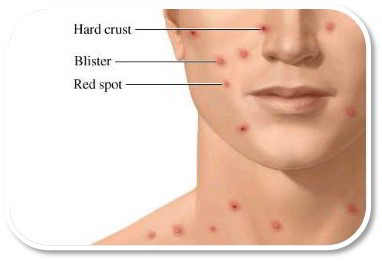
The illness is generally mild in children, but symptoms are more serious in young infants, mature teens and adults. Chickenpox may also be more serious in people who have decreased immunity, like people that have AIDS.
What Are The Symptoms?
The symptoms of chickenpox appear 1-3 weeks after infection. In kids, the illness usually begins with a moderate fever or headache; in adults, there may be more noticeable influenza-like symptoms. As infection with the virus advances, the following symptoms typically become noticeable.
- Rash in the type of harvests of miniature reddish spots that quickly become itchy, fluid-filled blisters; within 24 hours the blisters dry out, forming scabs; consecutive harvests happen for U6 days. The rash may be prevalent or consist of just a number of spots, and it can happen anywhere on the head or body.
- Occasionally, suffering during eating caused by spots in the mouth that have grown into ulcers.
An individual is infectious from about two days before the rash first appears until it completely crusts around in about 10-14 days.
The most common complication of chickenpox is bacterial infection of the blisters due to scraping. Other complications include pneumonia, which is more common in adults, and, rarely, inflammation of the brain (encephalitis). New-born babies and people who have decreased resistance are at high risk of complications. Quite seldom, if a girl gets chickenpox in early pregnancy, the disease may lead to fetal abnormalities.
What Might Be Done?
Chickenpox can generally be diagnosed from the look of the rash. Kids with moderate illnesses don’t need to see a physician, and rest and straightforward measures to reduce temperature are all that are needed for complete healing. Calamine lotion may help relieve itching. To prevent skin diseases, keep fingernails short and avoid scraping.
Individuals at risk of serious attacks, such as Infants, mature teens, adults and individuals with decreased resistance, should see their physician promptly. An antiviral drug may be given to restrict the effects of the disease, but it must be taken in the early phases of the sickness in order to be successful.
Kids who are otherwise healthy typically recover within 10-14 days from the start of the rash, but they may have permanent scars where blisters have gotten infected with bacteria. Teens, adults and individuals with decreased resistance take longer to recuperate.
Can It Be Prevented?
One attack of chickenpox gives lifelong resistance to the disease. On the other hand, the varicella zoster virus stays dormant within nerve cells and may reactivate years later, causing shingles.

 (52 votes, average: 4.52 out of 5)
(52 votes, average: 4.52 out of 5)